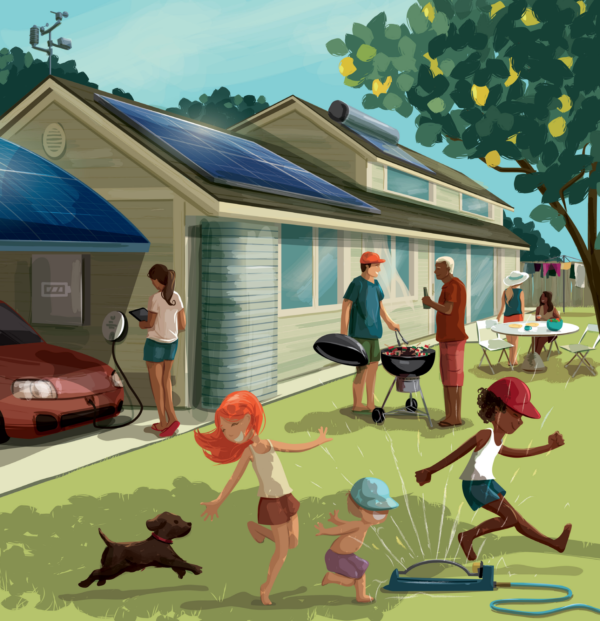As he launched the Clean Energy Council (CEC) proposed energy policies this morning, Kane Thornton, Chief Executive of the peak body for the renewable-energy industry, said, “Federal politics has failed energy consumers. Leadership from the next Federal Government is essential to deliver cheaper, cleaner and more reliable energy.”
He said it was time to put away the “big stick” of retribution against future price gouging by large energy providers, and instead capitalise on the “extraordinary momentum” that has contributed to a record $20 billion worth of wind and solar projects now under construction in Australia.
Overall the CEC favours robust management of Australia’s energy transition, rather than leave-it-to-the-states tactics.
In its 2019 Federal Election: 10 Clean Energy Policies, the CEC calls on “all political parties to adopt a target of zero emissions from the electricity sector well before 2050,” with a commitment to deliver at least 50% of Australia’s power by renewable energy — wind, solar, hydro — by 2030.
“New clean electricity generation does not require subsidies,” says the CEC, but overarching policies and targets, such as a combination of the widely supported National Energy Guarantee, a Clean Energy Target and an extended Renewable Energy Target, would give investors confidence in Government direction.
A subsequent key proposal is to support renewable-energy entry to the grid, with investment in desperately needed upgrade of Australia’s transmission network and establishment of Renewable Energy Zones — regional areas identified for their solar and wind resource, land suitability and workforce — in which planning and environmental assessments for renewable projects can be streamlined to encourage timely connection, and employment opportunities that develop a skilled workforce.
Solar-powered homes as a matter of course
From such overarching policies, CEC proposes building on Australians’ embrace of rooftop solar, with a national requirement to include solar systems on all new homes. “This could be implemented by the Federal Government working with state and territory governments to reform building codes, planning regimes and existing or new government programs relating to new housing,” says the CEC.
The solar-new-homes idea, which has also been proposed by the NSW Greens in the lead-up to the NSW state elections on March 23, capitalises on the fact that, “Installing solar power and battery storage is cheaper when installed during the construction of new homes, making the cost effectiveness and benefit to customers even better,” says the CEC’s 2019 Federal Election encourager to all political parties.

The CEC also proposes that parties develop targeted incentives to install battery storage, which can reduce overall network costs — by taking load off the grid — while reducing costs for consumers.
It points to thoughtfully designed state-based programs that support battery uptake, such as South Australia’s Marshall Government’s commitment to support installation of up to 90,000 battery systems, with mechanisms to ensure at least half of funding reaches low-income households or public-housing tenants. In Victoria, 10,000 homes will receive support to install batteries, a $40 million scheme which complements the Andrews’ Government’s $1.2 billion scheme to provide rebates and zero interest loans for rooftop solar on 650,000 homes.
Growing exports and industry
Big-picture thinking by the CEC advocates that Government prepare to capitalise on Australia’s clean-energy-export potential.
Research into clean commercial production of hydrogen using solar and wind energy is reaching encouraging outcomes in institutes around Australia, and Thornton proposes, “We should also begin planning the infrastructure to export renewable energy to the rest of the world through clean hydrogen and high-voltage DC cables.”
Economic opportunities abound in the current renewables boom, and Western Australia is among the states looking to position itself at the forefront of global lithium-ion battery manufacturing — taking advantage of Australia’s considerable lithium resources and worldwide demand for batteries.
The Federal Government should support the establishment of a lithium-ion battery manufacturing and recycling industry, says the CEC — again with the aim of boosting investor confidence in a sector where Australia could add innovation and value to a currently exported commodity.
In brief, the 10 recommendations from the Clean Energy Council’s policy directives:
- Commit to a target of at least 50 per cent renewable energy by 2030, as well as a zero-emissions electricity sector well before 2050.
- Accelerate reforms and finance support to develop Australia’s electricity transmission network for a clean energy future.
- Encourage the uptake of energy storage such as batteries and pumped hydro.
- Maintain the Small-scale Renewable Energy Scheme (SRES).
- Mandate solar power in all new homes.
- Support innovation in finance, technology and integration. Extend the Australian Renewable Energy Agency (ARENA) and the Clean Energy Finance Corporation (CEFC).
- Commit to the development of a clean energy export strategy.
- Support skills development to meet the needs of a growing industry.
- Support the establishment of a battery manufacturing and recycling industry.
- Develop a single national electrical safety body.
This content is protected by copyright and may not be reused. If you want to cooperate with us and would like to reuse some of our content, please contact: editors@pv-magazine.com.









By submitting this form you agree to pv magazine using your data for the purposes of publishing your comment.
Your personal data will only be disclosed or otherwise transmitted to third parties for the purposes of spam filtering or if this is necessary for technical maintenance of the website. Any other transfer to third parties will not take place unless this is justified on the basis of applicable data protection regulations or if pv magazine is legally obliged to do so.
You may revoke this consent at any time with effect for the future, in which case your personal data will be deleted immediately. Otherwise, your data will be deleted if pv magazine has processed your request or the purpose of data storage is fulfilled.
Further information on data privacy can be found in our Data Protection Policy.